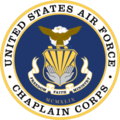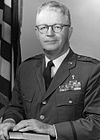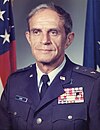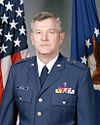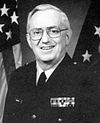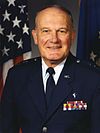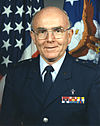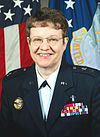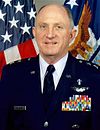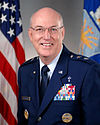The United States Armed Forces are the military forces of the United States. The armed forces consist of six service branches: the Army, Marine Corps, Navy, Air Force, Space Force, and Coast Guard. All six armed services are among the eight uniformed services of the United States, along with the U.S. Public Health Service Commissioned Corps and the NOAA Commissioned Officer Corps.

The Secretary of the Air Force, sometimes referred to as the Secretary of the Department of the Air Force, is the head of the Department of the Air Force and the service secretary for the United States Air Force and United States Space Force. The secretary of the Air Force is a civilian appointed by the president, by and with the advice and consent of the Senate. The secretary reports to the secretary of defense and/or the deputy secretary of defense, and is by statute responsible for and has the authority to conduct all the affairs of the Department of the Air Force.

The chairman of the Joint Chiefs of Staff (CJCS) is the presiding officer of the Joint Chiefs of Staff (JCS). The chairman is the highest-ranking and most senior military officer in the United States Armed Forces and the principal military advisor to the president, the National Security Council, the Homeland Security Council, and the secretary of defense. While the chairman of the Joint Chiefs of Staff outranks all other commissioned officers, the chairman is prohibited by law from having operational command authority over the armed forces; however, the chairman assists the president and the secretary of defense in exercising their command functions.

The Goldwater–Nichols Department of Defense Reorganization Act of October 4, 1986 made the most sweeping changes to the United States Department of Defense since the department was established in the National Security Act of 1947 by reworking the command structure of the U.S. military. It increased the powers of the chairman of the Joint Chiefs of Staff and implemented some of the suggestions from the Packard Commission, commissioned by President Reagan in 1985. Among other changes, Goldwater–Nichols streamlined the military chain of command, which now runs from the president through the secretary of defense directly to combatant commanders, bypassing the service chiefs. The service chiefs were assigned to an advisory role to the president and the secretary of defense, and given the responsibility for training and equipping personnel for the unified combatant commands.
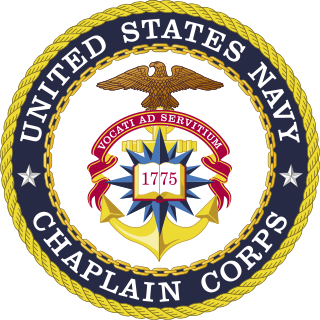
The United States Navy Chaplain Corps is the body of military chaplains of the United States Navy who are commissioned naval officers. Their principal purpose is "to promote the spiritual, religious, moral, and personal well-being of the members of the Department of the Navy," which includes the Navy and the United States Marine Corps. Additionally, the Chaplain Corps provides chaplains to the United States Coast Guard.

A military chaplain ministers to military personnel and, in most cases, their families and civilians working for the military. In some cases, they will also work with local civilians within a military area of operations.
The chaplain general is a senior chaplain in non-church organisations, such as the British and Canadian armies, and is responsible for the supervision of chaplains conducting religious services and ceremonies, representing the Christian faith in that organisation, and providing pastoral care and support within the organisation.

Religious Program Specialist (RP) is a designated rating within the United States Navy. As an essential member of Professional Naval Chaplaincy, RPs fulfill a crucial function in administering religious ministry within the Department of the Navy (DON). Together with chaplains, they form the Religious Ministry Team (RMT). In this capacity, RPs actively support the provision and facilitation of Religious Ministry, offering assistance and care to Navy and Marine Corps personnel, as well as their families, irrespective of their backgrounds and faith affiliations. Despite working in a religiously diverse environment, RPs are not mandated to hold religious beliefs nor perform pastoral counseling for the service members under their care. Due to the mobile nature of the units they may be assigned to, RPs can be stationed on Navy ships, at various Navy and Marine Corps commands, navy construction battalions, and other unique combatant units-rendering them globally deployable.
The structure of the United States Navy consists of four main bodies: the Office of the Secretary of the Navy, the Office of the Chief of Naval Operations, the operating forces, and the Shore Establishment.

The Chaplain of the United States Coast Guard (COCG) is the senior chaplain of the United States Coast Guard (USCG) and is attached to USCG headquarters in Washington, D.C. as a United States Navy Chaplain Corps officer who reports directly to the Commandant of the Coast Guard. The current Chaplain of the Coast Guard is Captain Jennifer Bowden.

The Chaplain Corps of the United States Air Force (USAF) is composed of both clergy—commissioned officers who have been endorsed and ordained by a religious organization—and enlisted Religious Affairs. As military chaplains, their main purpose is to support the free exercise of religion by members of the military service, their dependents, and other authorized personnel. They also provide advice on spiritual, ethical, moral, and religious-accommodation issues to the leadership of the United States Department of Defense.
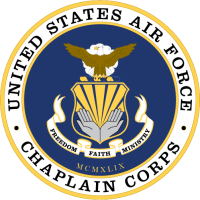
The Chief of Chaplains of the United States Air Force (HAF/HC) is the senior chaplain in the United States Air Force, the functional leader of the United States Air Force Chaplain Corps, and the senior advisor on religious issues to the Secretary and Chief of Staff of the United States Air Force.
In the United States armed forces, the Chiefs of Chaplains of the United States are the senior service chaplains who lead and represent the Chaplain Corps of the United States Army, Navy, and Air Force. The Navy created the first Office of the Chief of Chaplains in 1917; the Army followed in 1920, and the Air Force established its own in 1948 after it became a separate branch.

The Chaplain of the United States Marine Corps (CHMC) is a position always filled by the officers serving as Deputy Chief of Chaplains of the United States Navy as a "dual hatted" billet since 2000. The CHMC oversees religious ministry in the Marine Corps which one Commandant of the Marine Corps defined as "a vital function which enhances the personal, family, and community readiness of our Marines, sailors, and their families. Chaplaincy supports the foundational principle of free exercise of religion and helps to enrich the spiritual, moral and ethical fabric of the military."

The Armed Forces Chaplains Board (AFCB) is an organizational entity within the United States Department of Defense established to provide advice and recommendations to OSD officials on policies and issues related to the free exercise of religion and on all matters concerning religion, spiritual readiness, morality, ethics, morale, and military chaplains. It is made up of the three Chiefs of Chaplains and three active-duty Deputy Chiefs of Chaplains of the Army, Navy, and Air Force.

Religious symbolism in the United States military includes the use of religious symbols for military chaplain insignia, uniforms, emblems, flags, and chapels; symbolic gestures, actions, and words used in military rituals and ceremonies; and religious symbols or designations used in areas such as headstones and markers in national cemeteries, and military ID tags.

The United States Department of Defense (DoD) has a complex organizational structure. It includes the Army, Navy, the Marine Corps, Air Force, Space Force, the Unified combatant commands, U.S. elements of multinational commands, as well as non-combat agencies such as the Defense Intelligence Agency and the National Security Agency. The DoD's annual budget was roughly US$496.1 billion in 2015. This figure is the base amount and does not include the $64.3 billion spent on "War/Non-War Supplementals". Including those items brings the total to $560.6 billion for 2015.

United States military chaplains hold positions in the armed forces of the United States and are charged with conducting religious services and providing counseling for their adherents. As of 2011, there are about 2,900 chaplains in the Army, among the active duty, reserve, and National Guard components.
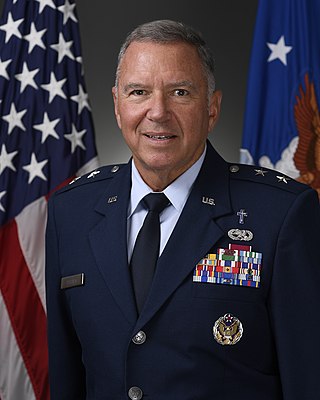
Steven Alan Schaick is a retired major general in the United States Air Force, and an ordained Presbyterian minister, who last served as the 19th Chief of Chaplains of the United States Air Force. He previously served as the 25th Deputy Chief of Chaplains of the United States Air Force, Headquarters U. S. Air Force, Pentagon, Washington, D.C. As the deputy chief of chaplains, he was a member of the special staff of the Chief of Staff, Schaick assists the Chief of Chaplains of the United States Air Force in establishing guidance on all matters pertaining to the religious and moral welfare of Air Force personnel and their dependents and directing and maintaining a trained, equipped and professional Chaplain Corps of more than 2,200 chaplains and chaplain assistants from the active and Air Reserve components. As a member of the Armed Forces Chaplains Board, he and other members advise the Secretary of Defense and Joint Chiefs of Staff on religious, ethical and quality-of-life concerns.
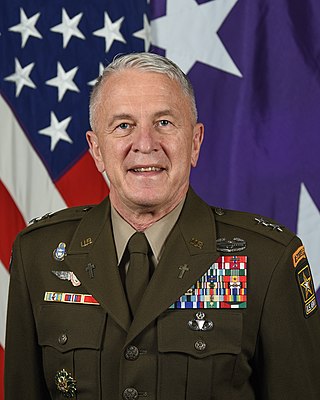
Thomas Lynn Solhjem is a retired United States Army major general who last served as the 25th Chief of Chaplains of the United States Army. Solhjem is the first ordained Assemblies of God minister to attain the position.
